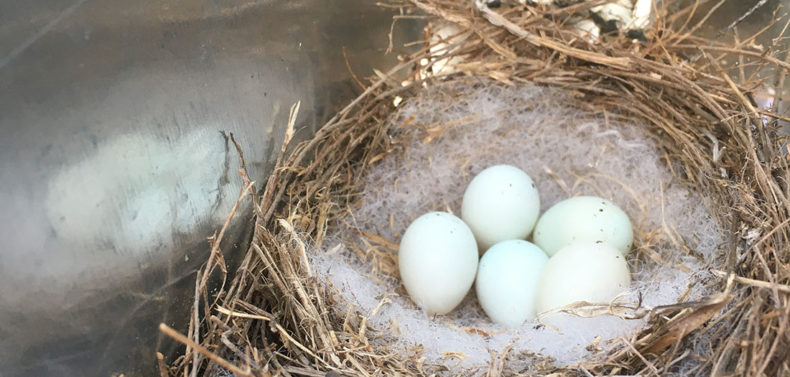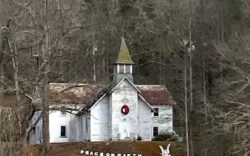“Hope is the thing with feathers that perches in the soul…”—Emily Dickinson
Weather-wise, it was a lovely spring in the Athens area, enticing us to spend more time outside. I’ve heard many say they felt a deeper appreciation for nature this year—valuing the solace and distraction of nature more than ever.
Good weather compels me to go camping, but this spring we stayed close to home and enjoyed what our backyard offered. Deer mosey through our yard most days, grazing their way through the neighborhood. We note the twins from last year and their mom, who looks like she’ll give birth again this June. Chipmunks scurry, and the squirrels chatter, but if you have a feeder, birds are the most constant companions.
Bird feeders that foil squirrels are preferable. They preserve seed for the birds and provide entertainment, as the squirrels cannot resist repetitive futile attempts. I became more sympathetic to squirrels this spring, when we saw one transfer babies by mouth from one tree to another. A wad of brown fur curled in her mouth, the squirrel picked her way carefully down a slope right past us, to climb up to the hollow in the black gum tree—twice.
The more you sit outside, the more you see, assuming you are quiet and really watching. Identifying birds is one way to pay closer attention. If you want to separate the nuthatches from the chickadees, or learn the types of woodpeckers, (three kinds come to our feeder), a good guidebook or app is essential.
This spring, as we enjoyed the goldfinches and cardinals, our attention diverted unexpectedly to something much larger. On a late afternoon in March, just as our home stay began, I saw a black vulture, (incorrectly referred to as a buzzard), circling lower and lower, until it dipped down into our woods, tipped its massive wings to dodge the trees and settled on a thick branch. Another came and then another, until there were 10. They sat awhile, and then tree-hopped through the woods, like they were playing high stakes musical chairs, with strategy for position and partner.
Their arrival unnerved me. Coinciding with the covid outbreak, I couldn’t suppress the feeling that they were ominous harbingers. I reminded myself their behavior was about mating—they weren’t (just) waiting for something/someone to die. One early morning, I saw one perched just outside my bedroom window. Apparently, we slept within 15 feet of each other. After that, I watched them fly out each morning and waited for their return in the evening. By the end of March, they were gone, and I missed them.
My attention returned to the usual characters at the feeder, with some new observations: the rose-breasted grosbeak, with a scarlet red triangle under his black head, dominated the feeder for two days on his way north; and the small downy woodpeckers brought their young to the feeder—their visits broadcast by the excited chatter from the youths eager for an outing.
The crows come every day; dropping into the woods at one end of the creek, they match its serpentine turns as they glide to their bathing spot. Later, they dry their wings, sitting on sun-lit branches.
We keep a close eye on the sassy Carolina wrens, due to their tendency to build nests with an admirable lack of regard for human convenience. The year they nested on the garage door mechanism we didn’t close the door all spring. They’ve also used the vine wreath on our front door and a basket on my gardening cabinet.
We didn’t find a wren nest this year, but outside my husband’s industrial shop, a pair of house finches chose the top level of a dust-collection system for their home. Eggs appeared, then babies—with their persistent gaping mouths, their parents darting in and out. The nest is empty now and, we hope they all made it.
Even more dramatic were the pair of Killdeers in the gravel parking lot, who compensated for their poor real-estate choices with over-the-top acting. Anyone nearing the back of the parking lot was greeted by a bird hopping along, seemingly injured, one wing dangling, hoping to lead the potentially dangerous predator in the opposite direction from their nest. Trying to safeguard the nest’s survival, my husband waited through the decoy act to watch the parent return to the nest—nestled between old train tracks running behind the shop.
Paying attention to the tenacity and beauty of small things that are both frail and tough expands my world even as it narrows life into a sharper focus.
What did you notice this spring? What pursuits are helping you endure this time? Send your observations, projects, and suggestions to [email protected].
Like what you just read? Support Flagpole by making a donation today. Every dollar you give helps fund our ongoing mission to provide Athens with quality, independent journalism.










